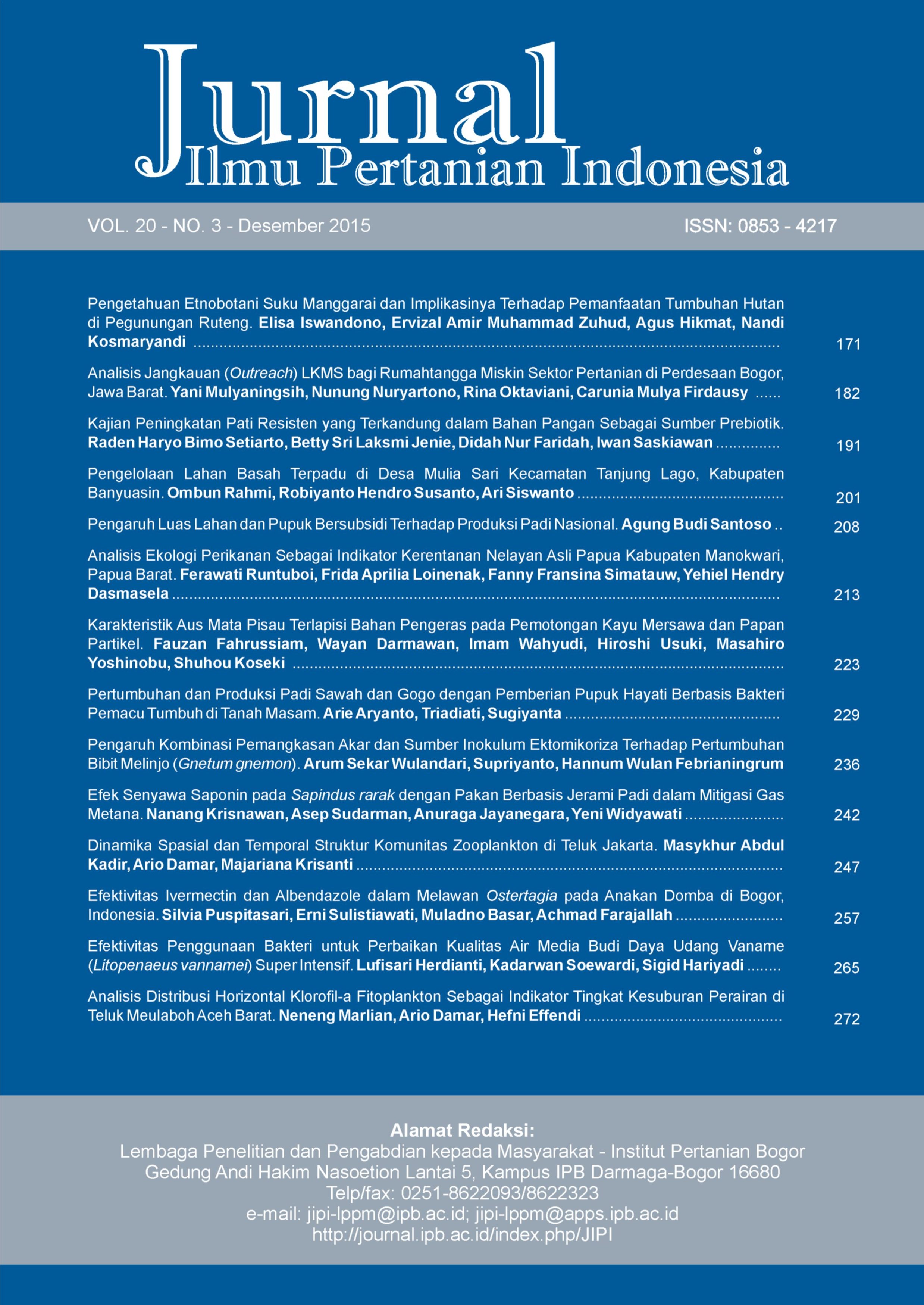Efek Senyawa Saponin pada Sapindus rarak dengan Pakan Berbasis Jerami Padi dalam Mitigasi Gas Metana
Abstract
The objective of the research was to study saponin in Sapindus rarak were added to the diet of rice straw ammoniation (20 & 40%), related to the effect in reducing methane emissions of ruminants and pattern of rumen fermentation were tested by in vitro. Completly randomized block design with four treatments and four replications was used. Variables measured were gas production total, methane production, dray matter digestibility (DMD), N-ammonia, VFA total, VFA partial, and population of protozoa. The results showed that the addition saponins in S. rarak as a source of rice straw ammoniation significant effect (P<0.05) of the total gas production, methane production, dray matter digestibility (DMD), N-ammonia, VFA partial, and population of protozoa. S. rarak use as a source of saponins with a dose of 20% on rice straw ammoniation was able to reduce methane gas production drop in gas production total, concentration of N-ammonia, and protozoa population.Downloads
References
Beauchemin KA, Kreuzer M, O’Mara F, McAllister TA. 2008. Nutritional management for enteric methane abatement: a review. Australian Journal of Experimental Agriculture. 48(2): 21-27. http://doi.org/c6gtk9
Conway EJ. 1962. Microdiffusion analysis and volumentric error. 5th edition. London (GB): Crosby Lookwood.
Cottle DJ, Nolan JV, Wiedemann SG. 2011. Ruminant enteric methane mitigation: a review. Animal Production Science. 51(6): 491-514. http://doi.org/fqjt9p
Finlay BJ, Esteban G, Clarke KJ, Williams AG, Embley TM, Hirt RP. 1994. Some rumen ciliates have endosymbiotic methanogens. FEMS Microbiology Letters. 117(2): 157-162. http://doi.org/cngcgb
Goel G, Makkar HPS, Becker K. 2008a. Changes in microbial community structure, methanogenesis and rumen fermentation in response to saponin-rich fractions from different plant materials. Journal of Applied Microbiology. 105(3): 770-777. http://doi.org/dj2pnb
Goel G, Makkar HPS, Becker K. 2008b. Effects of Sesbania sesban and Carduus pycnocephalus leaves and Fenugreek (Trigonella foenum-graecum L.) seeds and their extracts on partitioning of nutrients from roughage- and concentrate-based feeds to methane. Animal Feed Science and Technology. 147(1-3): 72-89. http://doi.org/dnsvnt
Hess HD, Kreuzer M, Diaz TE, Lascano CE, Carulla JE, Soliva CR, Machmüller A. 2003. Saponin rich tropical fruits affect fermentation and methanogenesis in faunated and defaunated rumen fluid. Animal Feed Science and Technology. 109(1-4): 79-94. http://doi.org/cwkrfj
IPCC. 2007. Climate change 2007: synthesis report. http://www.ipcc.ch/pdf/assessment-report/ayr4/syr/ ar4_syr_sym.pdf.
Iqbal MF, Cheng YF, Zhu WY, Zeshan B. 2008. Mitigation of ruminant methane production: currect strategies, constraints and future options. World Journal of Microbiology and Biotechnology. 24(12): 2747-2755. http://doi.org/dgfsxd
Jayanegara A, Makkar HPS, Becker K. 2009a. Emisi metana dan fermentasi rumen In Vitro ransum hay yang mengandung tannin murni pada konsentrasi rendah. Media Peternakan. 32(3): 185-195.
Jayanegara A, Sofyan A, Makkar HPS, Becker K. 2009b. Kinetika produksi gas, kecernaan bahan organic, dan produksi gas metana In Vitro pada hay dan jerami disuplementasi hijauan mengandung tannin. Media Peternakan. 32(2): 120-129.
Leng RA. 1991. Aplication of Biotechnology to Nutrition of Animal in Developing countries. FAO Animal Production and Health Paper.
Ogimoto K, Imai S. 1987. Atlas of rumen microbiology. Tokyo (JP): Japan Scientific Societies Press.
Theodorou MK, Brook AE. 1990. Evaluation of a New Laboratory Procedure for Estimating the Fermentation Kinetic of Tropical Feeds. Chatham (UK): Contractor Report (EMC X0162) for the Natural Resources Institute.
Thorpe A. 2009. Enteric fermentation and ruminant eructation: the role of methane in the climate change debate. Climate Change. 93(3/4): 407-431. http://doi.org/fckbws
Wina E, Muetzel S, Hoffman E, Makkar HPS, Becker K. 2005. Saponins containing methanol extract of Sapindus rarak affect microbial fermentation, microbial activity and microbial community structure in vitro. Animal Feed Science and Technology. 121(1-2): 159-174. http://doi.org/bv7bjq
Yunilas. 2009. Bioteknologi Jerami Padi Melalui Fermentasi Sebagai Bahan Pakan Ternak Ruminansia. Medan. (ID): Universitas Sumatera Utara.
This journal is published under the terms of the Creative Commons Attribution-NonCommercial 4.0 International License. Authors who publish with this journal agree to the following terms: Authors retain copyright and grant the journal right of first publication with the work simultaneously licensed under a Creative Commons Attribution-NonCommercial 4.0 International License. Attribution — You must give appropriate credit, provide a link to the license, and indicate if changes were made. You may do so in any reasonable manner, but not in any way that suggests the licensor endorses you or your use. NonCommercial — You may not use the material for commercial purposes.























